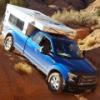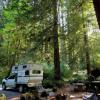The settings in the built in BMS are usually designed to prevent rapid damage, not to provide the optimized values. Think of them more as circuit breakers than regulators, they trip to prevent damage, but that usually means something else is not right. In generally use, your BMS shouldn't really need to do anything as the rest of your equipment is providing the 'optimized' values that are well away from the BMS values. So set 'optimized' values on your charger (which I would argue would be a bulk charge around 14V, float around 13.3V) then set 'oh sh#$#t' values on the BMS, max voltage 14.5V, min voltage 11.5V, min temp -5C etc.
As for charging the battery, there is really no great way to stop the charge at 80%, and to some degree no reason to do so. However charging above 14V doesn't buy you much of any extra capacity and drives your cells out of balance.
On my LifePO4 install I can monitor the individual cell voltages, and what I have noticed is that during charging, once the battery voltage gets above ~3.45 - 3.5V per cell (13.8 - 14.0V for the pack) the battery is almost fully charged (~ 95% SOC based on the BMV and BMS) and at this point what mostly happens is that the cells get out of balance - that is some end up at 3.53V while others are at 3.47V. Below this they all stay very well balanced, typically less than 10mv between cells, so I typically cut the charge off at 13.8V, or 14.0V if I expect to be using the batteries hard.
As for the charge for storage - there is some evidence that storing lithium batteries fully charged slightly shortens their lifetime, thus the recommendation to store at 30 - 60% SOC. On the flip side, the same studies said storage temperature had a much greater effect. Secondly, if you have a built in 'dumb' BMS (like battleborn) then it is always drawing a little bit of current from the batteries, and by starting at 100% SOC, you have more time before the BMS draws the batteries down too low, albeit this is probably years.














